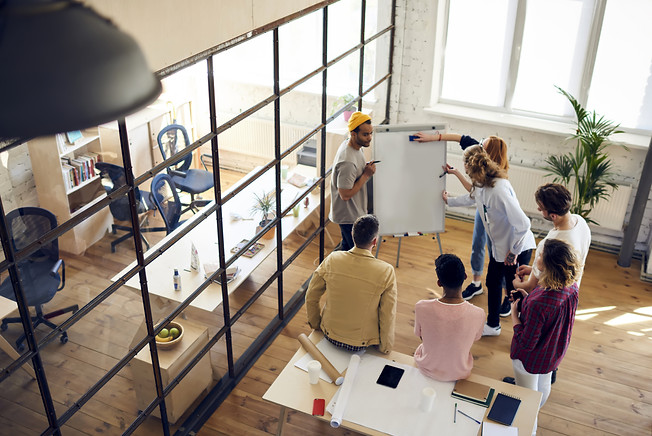
Immediate Value of Sustainability
We picture a world where people can live and work in healthy, thriving, productive spaces that are also good for the planet. In the modern world, we spend 90% of our time indoors; buildings are people’s living and working environments and they deeply affect people’s satisfaction, health, and work performance (1,2,3,4).

It is essential that buildings have an optimal environment with the freshest air, enjoyable natural lighting and views, and balanced thermal comfort. These three features are important benefits of a green building and they are essential to incorporate in an energy retrofit or design/build project because they have the largest positive impact on people’s lives as well as a company’s profits (1,3,5,6).
Common Green Practices
Over the last twenty years, companies have mostly approached environmental sustainability as a form of risk management in preparation for the future of energy as well as a source of positive public relations and corporate reputation (7). Some companies that are sustainability leaders view going green as a core part of their business growth (7). However, these companies have mostly focused on reducing waste, in-house recycling, and reducing energy, as well as investing in R&D for new green products (7).
However, we would suggest that many of these common green practices are not the “low hanging fruit” for sustainability. As an example, installing solar panels on a business’s roof is a good investment but has limited immediate value and moderately long payback periods, and thus it is not the most attractive sustainable solution. Solar panels today typically cost less per square meter than a glass window. The reason for this is that glass windows are something people value more than solar panels. While solar panels are unseen on a business’s roof, windows bring immediate value to a business.

Immediate Value
Businesses need to consider how sustainability initiatives and energy retrofits will boost corporate profits in the next five years and whether the payback period justifies the upfront costs. We suggest that businesses incorporate sustainable features that offer immediate benefits to their company by energizing their workforce and boosting sales.
Revisiting the previous example, high-quality windows can reduce moisture and mold, provide healthy natural light, and give the best thermal comfort, which all positively effect the bottom line of a business. It is well understood today that an office with no windows and poor-quality fluorescent lighting will struggle retaining employees (1,5). And now there is also clear research that shows that natural daylighting reduces employee sick days and provides a large boost in employee productivity at the office (1,4,5).
However, covering buildings with floor-to-ceiling windows comes with durability issues and poor energy efficiency. And in a retrofit, it is difficult or expensive to knock down walls and add windows, which comes with more environmental sustainability problems. But there are natural lighting solutions such as tubular skylights, which pipe daylight into offices, that can greatly reduce energy usage while boosting employee productivity. With these types of smart energy solutions, businesses can provide immediate improvements in employee productivity while protecting the environment and saving energy as value-added benefits.

New Emerging Energy Future
From our research we’ve discovered three features of a green building that can provide immediate value as well as energy and environmental benefits: indoor air quality systems, daylighting and automated lighting systems, and building systems that improve thermal comfort. These value-added solutions for sustainability are the “low hanging fruit” that a smart and proactive business can pursue in the New Emerging Energy Future.
References
-
Terrapin Green (2012). The Economics of Biophilia: Why designing with nature in mind makes financial sense. 40pp.
-
Allen, J. G., MacNaughton, P., Satish, U., Santanam, S., Vallarino, J., & Spengler, J. D. (2015). Associations of cognitive function scores with carbon dioxide, ventilation, and volatile organic compound exposures in office workers: a controlled exposure study of green and conventional office environments. Environmental health perspectives, 124(6), 805-812.
-
MacNaughton, P., Pegues, J., Satish, U., Santanam, S., Spengler, J., & Allen, J. (2015). Economic, environmental and health implications of enhanced ventilation in office buildings. International journal of environmental research and public health, 12(11), 14709-14722.
-
MacNaughton, P., Satish, U., Laurent, J. G. C., Flanigan, S., Vallarino, J., Coull, B., ... & Allen, J. G. (2017). The impact of working in a green certified building on cognitive function and health. Building and environment, 114, 178-186.
-
Al Horr, Y., Arif, M., Kaushik, A., Mazroei, A., Katafygiotou, M., & Elsarrag, E. (2016). Occupant productivity and office indoor environment quality: A review of the literature. Building and environment, 105, 369-389.
-
Loftness, V., Hartkopf, V., Gurtekin, B., Hua, Y., Qu, M., Snyder, M., ... & Yang, X. (2001). Building Investment Decisions Support (BIDS). ABSIC Research, 2002.
-
Bonini, S., & Görner, S. (2011). McKinsey Global Survey results: The business of sustainability. McKinsey & Company 2011.
